Mary Cooper's New Orleans Garden
In her New Orleans garden, Mary Cooper has achieved lushness with very little and abundance on an extremely small scale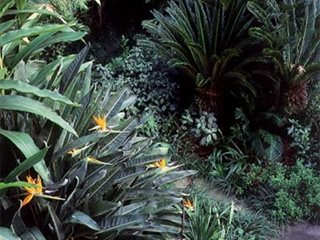
Photo by: Clay Langdon.
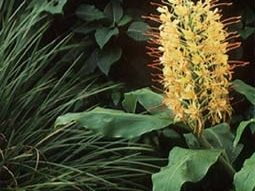
Photo by: Clay Langdon.
The first time Mary Cooper came to my house for dinner, she brought homemade cream cheese — in a French jam jar, covered with cheesecloth — and an armload of the most beautiful camellias I had ever seen. There were divine pink-and-white ‘Pink Perfection,' curly dark red ‘Professor Charles S. Sargent,' curly pink ‘Debutante,' ‘White Empress,' gorgeous, shell-like ‘White By the Gate,' and ruffly pink ‘Carter’s Sunburst.' We floated them in soup plates and smashed them into wine rinsers and water pitchers (‘Carter’s Sunburst’ has fabulous long stems) until my tiny dining room was an explosion of candlelit red and white and pink. At that moment I decided I absolutely adored Mary Cooper.
But then I saw her garden, and I really fell in love.
The camellias are there, of course. And navel and sweet orange trees, two kumquats, a Meyer lemon, and two satsumas. (“Because of the freezes, citrus is kind of a risky business in New Orleans,” she says, “but it’s the one thing I’ll take a risk on.”) There is a persimmon and a papaya and a pear and a pomegranate tree and a fence covered entirely by nasturtiums. There is common jasmine and Arabian jasmine ‘Grand Duke of Tuscany’ and an unusual yellow night-blooming jasmine (“It’s a mutant or something — I found it in a friend’s cow pasture”). Against one wall of her house are old roses named ‘Prosperity’ and ‘Maggie,' and outside her kitchen door is the shrub Kashmir bouquet, Clerodendrum chinense ‘Pleniflorum’ (“the good kind,” she says, the kind that is barely pink and sweet smelling rather than purple and “stinky”). And then there are what she calls the “shockers”: the gingers; the birds of paradise; the lycoris, or spider lilies, red and gold blooms that seem to “come out of nowhere” on a long, leafless stem. “They are so snazzy,” she says. “I just love them.”
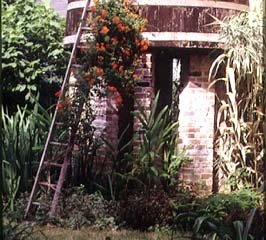
Photo by: Clay Langdon.
All this surrounds an 1880s house that was moved in 1908 to an idyllic spot across from the Mississippi River in a section of New Orleans known as Bywater. The house, with its wide plank floors and tall, tall ceilings and rooms painted Paris green, is wonderful, but Cooper bought it, she says, for the lot. Her earlier yards had been “teeny patches of grass” she could “almost cut by hand.” So when she saw the deep backyard and long side yards of her current house, she knew she could make a ''little Eden.” And it is.
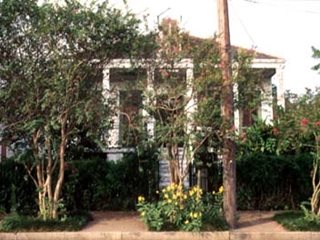
Photo by: Clay Langdon.
When I visit, the three cats (whose own catwalk up to the back porch has been almost entirely taken over by plumbago) sprawl under the table in Cooper’s dining room, where she is caning the seat of a Regency chair. She saw a woman in California doing the same thing years ago, somehow picked up the art, and now does it for a living. While she works, I munch on sugar cookies scented with lemon and fresh rosemary from her backyard and listen to her tell me about the first plants she put in the ground, 15 years ago.
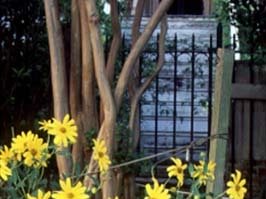
Photo by: Clay Langdon.
They were crape myrtles she bought cheap, in a blind buy, and she was determined to get them, with their huge root balls, into the ground. “It was raining and freezing cold, and the house was practically falling down,” she says. But she stuck it out, digging hole after hole in her bare yard. Just when she was about to give up, she says a man passed by in his car, rolled down the window, and said, ''You don’t know me, but I think what you’re doing is wonderful.'' And I thought, OK, I can go on.” Better yet, all the bushes turned out to be the same shade of watermelon pink. Spurred by that first victory, she set about plotting the rest of her garden, with a certain “wildness” as her goal: “I liked the idea of not having a garden that was perfect.”
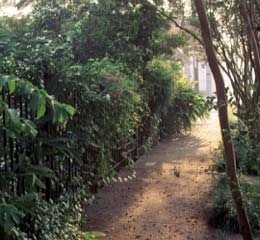
Photo by: Clay Langdon.
She also wanted to use plants significant to the area. She has Phlox divaricata ‘Louisiana’ and Louisiana iris, and clumps of indigo and sugarcane, the state’s first two agricultural crops. “The fig trees,” she says, “came with the Italians in the mid-19th century,” and the branches of the sago palms, which are not palms at all but descendants of pines and other cone-bearing trees, have always been used in the local Catholic churches’ Palm Sunday services. Cooper planted giant reed alongside her cistern (which houses goldfish) because a friend said her grandmother had done the same. Another friend told her that nuns brought Rangoon creeper (Quisqualis indica) over from Cuba, so she planted it in front. Artemisia absinthium, or wormwood, is what absinthe is made of; and vetiver, Cooper’s favorite plant, is said to repel that New Orleans scourge, termites.
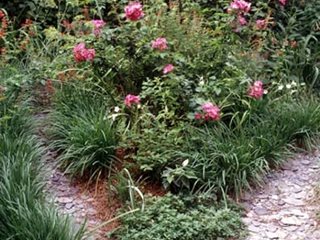
Photo by: Clay Langdon.
As a gardener, she is practical: “I’m not into nursing anything along. It’s just got to get in the ground and survive.” But she can be lyrical when talking about her plants. The night-blooming cereus, for example, “looks like a tutu when it opens. I can see why champagne is the only thing to drink while watching.” (Waiting for it to open is a famous New Orleans pastime.) The blossoms of the pomegranate tree look like “bright-orange tissue paper that has been crumpled,” and the night-blooming jasmine “smells like cake icing.” She loves the name of her Japanese varnish tree, Firmiana simplex, because “it sounds like poetry.”
Her enthusiasm is contagious. I moon over a mysterious shrub with lavender blooms, and she gushes that “it looks like Haiti.” When I admire something else, she gives me a cutting. “What is it?” I ask. “I don’t know. But look at the buds. Aren’t they cool? They look like raspberries.”
